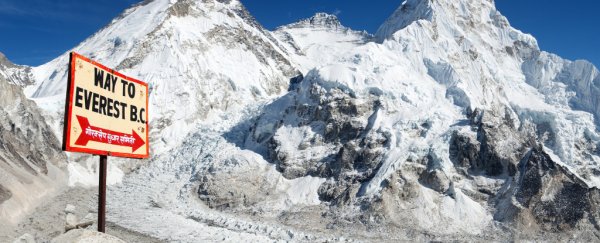Late last month scientists undertook a pretty amazing feat, successfully installing five automated weather stations across the Himalayan region, including the highest weather station in the world, near the very top of Mount Everest.
In a long-form feature by National Geographic writer Freddie Wilkinson, the international team explain how they battled extreme weather, record crowds and a forgotten attachment.
"This is a new window into the planet," Paul Mayewski, a climate scientist from the University of Maine and the expedition's scientific leader told National Geographic.
"We believe the best way to do science on Everest isn't just to do one kind of science, but do many kinds of science."
The weather stations aren't up there just for measuring temperature (although you can check out that data here); the reason why researchers put them so high up is to investigate something called the 'South Asia jet stream'.
Jet streams are thin and fast currents of air which flow across the surface of Earth; although we know they are formed by atmospheric heating, they aren't well understood.
According to the researchers, Mt Everest is one of the few mountains tall enough to actually protrude into the South Asia jet stream, making it a perfect location to secure some lightweight, automated weather stations to collect measurements.
The team also had their sights on drilling a variety of ice cores on Mt Everest, both at a lower spot on the mountain called South Col and at the summit itself.
Drilling at South Col - an area at 8,020 metres (8,770 yards) above sea level - wasn't an issue, and the team collected a large number of 50 centimetre (19.7 inch) lengths of valuable ice cores.
Ice cores, similar to the rings on a tree, keeps a record of seasons over many years. When analysed in the lab, this can show researchers things like changes in molecules in the air hundreds of even thousands of years ago.
Similar cores from Antarctica, Greenland, and the Swiss-Italian Alps have been able to tell us an impressive range of historical information – things such as lead level in the 1300s and climate data from 800,000 years ago.
Although the team was aiming for the summit to put up the final weather station and drill more cores, the record crowds on Everest changed their plans, and the international team ended up placing the final and tallest station on 'the Balcony' – a flat section of the mountain near the summit, at a height of 8,430 metres, and just 420 metres from the very top.
"There was some disappointment, yeah," Baker Perry, a geographer from Appalachian State University recalled, "but none of us was there to summit Everest."
The Balcony was too contaminated by human waste and oxygen canisters people had left behind to drill any cores, but the researchers were still able to assemble the station despite discovering when they arrived that they were missing an important piece.
With quick thinking and a shovel handle that had similar proportions, they replaced the piece and eventually managed to cobble the station together.
Through all that hardship, the team accomplished an important scientific feat; while they have more goals in mind, it might be time to relax.
"It would be worth going back with radar to learn more about this glacier and to drill all the way to the bottom," one of the team, University of Maine climate scientist Mariusz Potocki said.
"But my wife said she'd divorce me."
